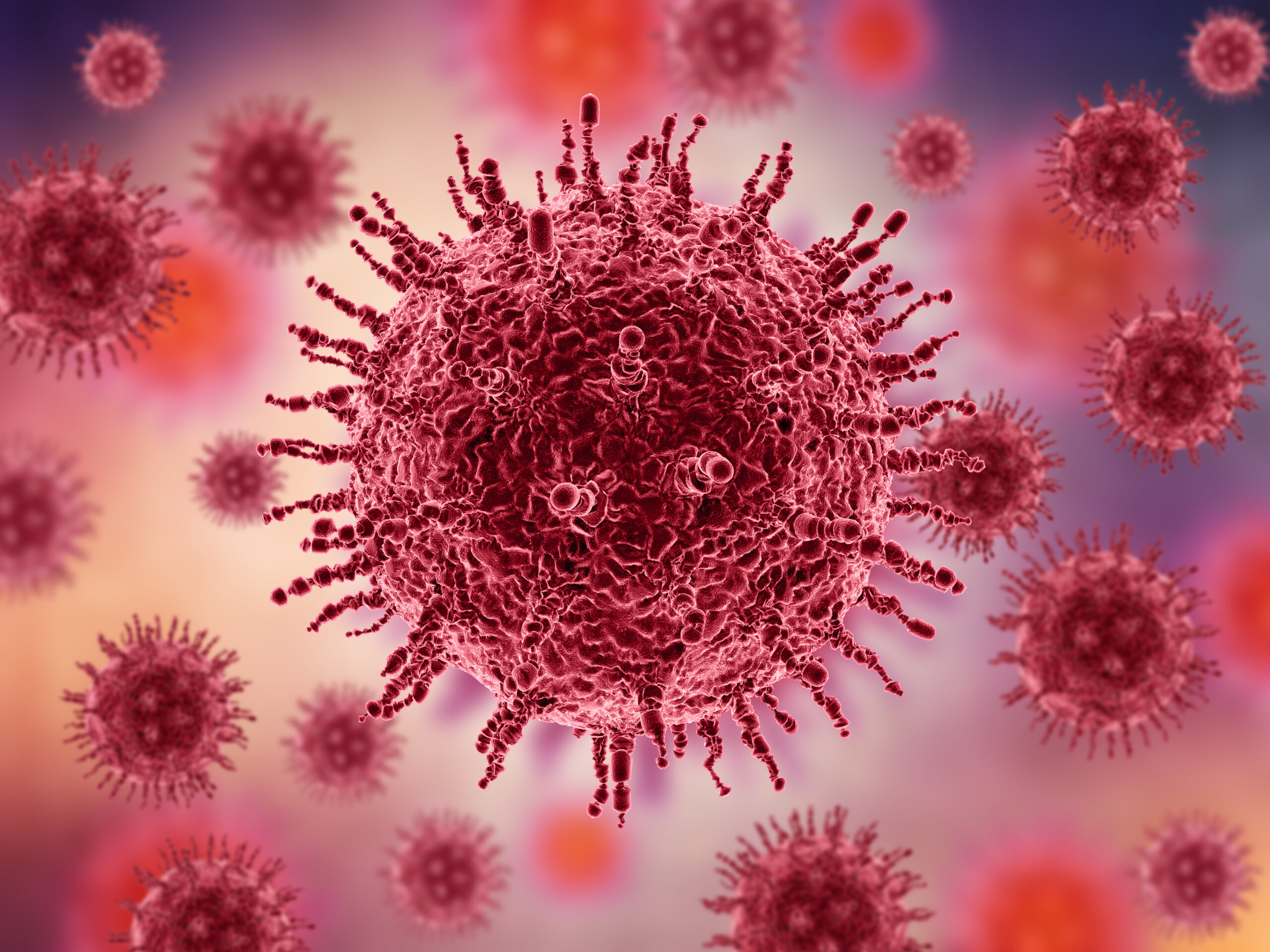A viral infection is initiated by the infiltration of a virus into the host's body, resulting in its rapid proliferation. Unlike bacteria, viruses are minuscule infectious agents that exclusively reproduce within the cells of a host organism.
Upon entry into the body, viruses penetrate host cells, hijacking their internal mechanisms for replication and dissemination. This process often damages the host cells and prompts the immune system to mount a response.

Viruses![]() represent a diverse group of infectious agents responsible for various diseases. For instance, the common cold, characterized by viral inflammation of the throat and paranasal sinuses, can be attributed to over 200 virus types. These viral infections
represent a diverse group of infectious agents responsible for various diseases. For instance, the common cold, characterized by viral inflammation of the throat and paranasal sinuses, can be attributed to over 200 virus types. These viral infections![]() are most commonly transmitted through direct contact with an infected individual, droplets, and upper respiratory tract infections. Cold symptoms typically manifest during decreased immune function, such as in spring and autumn.
are most commonly transmitted through direct contact with an infected individual, droplets, and upper respiratory tract infections. Cold symptoms typically manifest during decreased immune function, such as in spring and autumn.
Other viral diseases include:
Viral infections, such as rhinopharyngitis, commonly known as the common cold, are prevalent. Various pathogens, including rhinoviruses and adenoviruses cause them. On average, adults experience 2 to 4 cold episodes annually. Furthermore, there are other viral infections, such as acute influenza, caused by RNA viruses. These infections can affect the throat, larynx, tonsils, paranasal sinuses, and middle ear, leading to inflammation.
The course of the viral infection, i.e., the symptoms![]() occurring at that time, depends on the specific disease. For example, typical symptoms of a cold
occurring at that time, depends on the specific disease. For example, typical symptoms of a cold![]() include:
include:
When it comes to the flu![]() , you may experience:
, you may experience:
Less common manifestations of the flu include a severe sore throat and a runny nose. Nevertheless, diarrhea is possible with this viral infection, particularly in little kids. In addition to fever, it is one of the reasons for severe dehydration of the organism, which can happen during the infection. Please remember that signs develop and can change at various phases of infection. For example, a dry cough frequently turns into a wet one used to expectorate the collected secretions.
Each infection develops at a specific pace and proceeds in several steps. The first signs of an upcoming disease are usually general body weakness, lack of energy, drowsiness, and fatigue. At this time, the virus is just hatching in the human body.
In the first phase of viral infection, i.e., the vascular phase, we observe several symptoms: sore throat, fever, cough, and rhinitis. Further development of the infection leads to further symptoms, such as headache or muscle and osteoarticular pain.
The viral infection usually lasts 5-7 days. The duration of the disease may vary depending on many factors:
It is worth knowing that bacterial superinfection may also occur in the case of a viral infection, leading to a more severe disease. Such situations are rare, but the course of the condition cannot be ruled out. The weakened body then has no strength to defend itself against further pathogens, and its natural protective barrier is violated, which makes it easier for harmful factors to enter the body.
The question often arises among patients: Is influenza caused by a viral or bacterial infection? The clarification has been provided earlier. In both cases, viruses are the source of infection; influenza is not attributed to bacteria.
It is imperative to delineate the disparities between viral and bacterial infections![]() . Viruses are infectious entities at the interface of the living and non-living realms. Lacking a cellular framework, they replicate by utilizing the host's cells in living organisms, including humans, various animals, plants, fungi, and even bacteria.
. Viruses are infectious entities at the interface of the living and non-living realms. Lacking a cellular framework, they replicate by utilizing the host's cells in living organisms, including humans, various animals, plants, fungi, and even bacteria.
It is worth noting that some infections may be caused by both viral and bacterial. This is the case with pharyngitis and tonsillitis, also known as angina. How can you distinguish a viral infection from a bacterial infection? In this case, the former manifests with a fever of up to 39 degrees, severe sore throat, and mucosal congestion.
For comparison, bacterial (streptococcal) angina manifests with a fever exceeding 39 or even 40 degrees, chills, intense sore throat, muscle pain, enlarged lymph nodes, and a characteristic white coating on the tonsils.
As for other comparisons, streptococcal strep throat is much more severe than a viral cold, and compared to the flu, it is distinguished by severe sore throat. Bacterial pneumonia is characterized by a very high fever (above 40 degrees) and a strong, wet cough.
Differences in laboratory test results may also be indicated. While leukopenia and lymphocytosis occur in viral infections, leukocytosis, i.e., an increased number of white blood cells, is typical of viral infections.
The incidence of viral infections in children![]() surpasses that in adults, with children experiencing up to 8-9 colds and frequent flu episodes annually. Factors contributing to this trend include the relatively low effectiveness of the immune system, particularly after six months from birth, and the consequent reliance on maternal antibodies until the child develops independent immunity in preschool and school age.
surpasses that in adults, with children experiencing up to 8-9 colds and frequent flu episodes annually. Factors contributing to this trend include the relatively low effectiveness of the immune system, particularly after six months from birth, and the consequent reliance on maternal antibodies until the child develops independent immunity in preschool and school age.
The manifestations of viral infections in infants are typically characterized by fever, cough, and apnea. At the same time, young children commonly exhibit symptoms such as nausea, vomiting, and diarrhea, especially in cases of flu.

In managing viral infections in children, priority should be given to administering age-appropriate fever-reducing and pain-relieving medications, cough remedies, and vasoconstrictors for rhinitis.
Regarding the return of children to kindergarten post-infection, while no strict guidelines exist, the child must be devoid of fever or low-grade fever and any other acute symptoms. It's essential to remember that children can remain infectious for up to 10 days from the onset of the infection.
For pregnant women![]() , it is important to protect against viral infections. A viral infection is a contagious condition. However, the good news is most viruses will not harm the fetus. Nevertheless, some of them may provoke miscarriage or birth defects.
, it is important to protect against viral infections. A viral infection is a contagious condition. However, the good news is most viruses will not harm the fetus. Nevertheless, some of them may provoke miscarriage or birth defects.
The flu and the common cold are examples of viral infections. Other examples are:
Pregnant women can get exposed to viral infections by other people. That is because they spread straight through touching, kissing, or sexual activity. They may also get them indirectly, e.g., through coughing or sneezing and contact with infected surfaces, food, and water. Being exposed does not mean the individual will become sick.
You should pay close attention to the thermometer readings. A temperature above 38 degrees may be dangerous for the fetus in this phase of pregnancy, so after consulting a doctor, it should be reduced with antipyretic drugs approved for use in this particular period of life. You should also see a doctor if the infection does not subside after 3 days and even more so if the symptoms worsen.
A specialist may often diagnose viral infection![]() by listening to patients' symptoms and examining them.
by listening to patients' symptoms and examining them.
They might use imaging tests if they believe the patient has a viral infection causing severe inflammation in internal organs. We usually talk about X-rays, ultrasound, MRI, or CT imaging. Those methods will not diagnose a viral infection but can help specialists understand how it influences the organism.
The doctor may collect and send body fluid or tissue samples to a laboratory where the specialists will look for indications of a viral infection. Types of samples they might take include:
During treatment![]() , it is essential to address inflammation symptoms in the body, including fever, sore throat, headache, muscle and joint pain, and sinus discomfort.
, it is essential to address inflammation symptoms in the body, including fever, sore throat, headache, muscle and joint pain, and sinus discomfort.
Secondly, it is worth supporting the immune system in the fight against pathogens. The ideal solution is dual-track measures. In this context, specialists can recommend an over-the-counter drug for viral infections containing ingredients such as:
Please remember that antibiotics for viral infections are ineffective and inadvisable. These types of drugs only work on bacteria.
If the patient does not have a high fever, it is worth basking in a warm bed (however, you should not overheat in the case of high temperature). You should also drink plenty of water and air your apartment regularly.

Complications following a viral infection may persist for several days or even weeks. Typical and harmless consequences are:
A bigger problem is bacterial superinfections, such as sinus infections and subsequent, more severe infections, especially after the flu.
The immune system![]() defends the organism against infections. It makes proteins named antibodies that counteract or kill microorganisms like viruses and bacteria. You get protection from a distinguishing condition when the immune system produces an antibody.
defends the organism against infections. It makes proteins named antibodies that counteract or kill microorganisms like viruses and bacteria. You get protection from a distinguishing condition when the immune system produces an antibody.
When your immune system works correctly, it differences between cells that are yours and those that do not belong in the organism. Then it activates and mobilizes to kill microorganisms that may harm you.
The response depends on the virus type and where it enters the organism. The immune system can identify the intruder (thanks to the virus's protein coat) and initiate suitable immunological processes.
The humoral answer involves the production of antibodies characteristic of a given virus that neutralizes its destructive existence. In turn, the cellular response is associated with the infected cells' recognition and the activation of cytotoxic mechanisms against them, aimed at their destruction to stop the virus from multiplying and spreading throughout the organism.
After eliminating the virus from the body, the immune system maintains the so-called immunological memory, i.e., protection against repeated infection with the same virus in the future.
But this process doesn’t always go this smoothly. Sometimes, the immune system doesn’t function correctly. For example, it may be too weak to fight with the invading microorganisms or establish too powerful of a reaction.
Prevention![]() plays a fundamental role in preventing viral infections.
plays a fundamental role in preventing viral infections.
Pharmacological prevention also plays an essential role in the case of people with reduced immunity (children, seniors, chronically ill people, and taking certain medications). It involves, among others, supporting the immune system. Get vaccinated. There are vaccines for numerous bacterial infections.
Immunity can also be supported by following specific dietary recommendations. A diet that strengthens the immune system should include products such as: